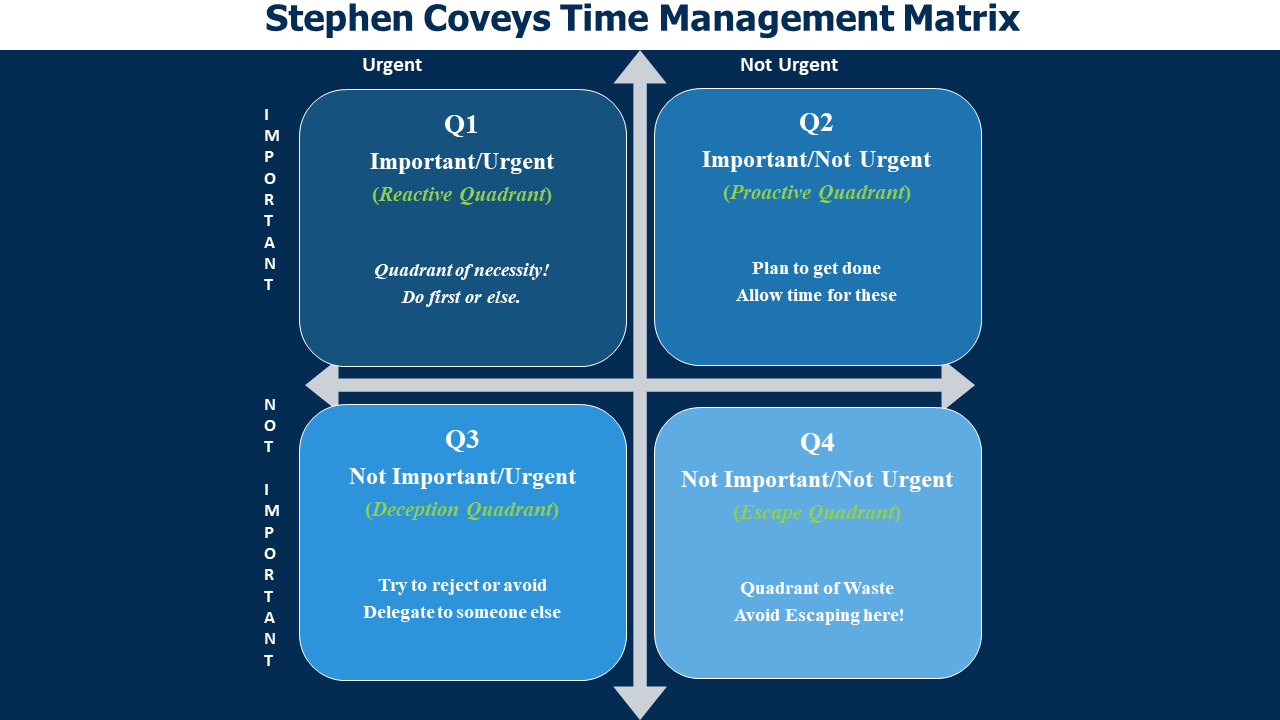
28 Sep 2021 How Prioritising using the Time Management Matrix can improve productivity
When I talk to people about prioritising their workload or their time, I almost always use Stephen Covey’s Time Management Matrix. It’s been around a long time, but I love how it often reveals our inherent tendency to focus on urgent tasks at the expense of the important tasks we have to do.
Here is the Time Management Matrix as I usually present it. Every task we need to do will usually sit in one of the following four quadrants based on their urgency and importance. (Determining what aspects of your work are important is really a whole other discussion – we spend a surprising amount of time on this topic alone in my training. (See my Personal Productivity Training) For now, think of important tasks as those that relate to what you are paid to do.)
Here is a brief overview of each of the four quadrants in the time management matrix.
 Q1 – Important/Urgent
Q1 – Important/Urgent
Quadrant 1 is the quadrant of necessity. Tasks or projects that fit into this quadrant are those that are both urgent and important. They often have a way of getting attention, in fact they often demand attention.
Some of the tasks in this quadrant will be foreseen, but there will occasionally be some that we didn’t see coming. Things that are dropped onto us at short notice, or things that break, are largely unforeseen. If you think about a factory, if the production line stops, that is clearly both urgent and important to deal with.
Of course, there are those important tasks that we’ve known about for some time but that weren’t urgent, but now we find ourselves up against a deadline and, all of a sudden, they turn up in this important and urgent quadrant.
Things in Q1 need to be done, and they need to be done first. You can rarely ignore them! There are usually unpleasant consequences of ignoring things in this quadrant.
Q2 – Important/Not Urgent
In this quadrant of the time management matrix sit all those tasks that are important but not urgent. Things such as your own planning, preparation, knowledge building or ‘looking after self’ sit in this quadrant. They often require some effort to complete and sometimes they can take considerable time, over days or even weeks, to get done. And of course, these are often the tasks we procrastinate about doing because of the lack of urgency!
Of course, as I mentioned earlier, a project sitting in Q2 may become urgent in time. The due date that was once a few weeks away is suddenly upon us and before we know it, that project belongs in Q1.
We need to plan to get these important/not urgent things done. Try to block time out in your calendar and schedule them in. You can view my article on Time Blocking here.
Q3 – Not Important/Urgent
Quadrant 3 is the tricky quadrant, as I like to say. These are tasks that are masquerading as important, based upon their sense of urgency. However, if you examine them closely, you’ll realise that they are not really important … at least not to you anyway!
Things such as an unannounced visitor, a trivial request or meetings of little value often sit in this quadrant. A good proportion of the emails in your inbox probably belong in this category as well.
They are usually more important for the other person than they are for you. But this is why it’s tricky. How do you determine their importance? You often don’t realise that a request is not important until you get halfway through it, or you sit back a reflect on it later.
We need to try and identify tasks in this category and either reject them or push back against them nicely but insistently. If possible, delegate them to someone else so that you can spend your time on the important tasks on your list.
Q4 – Not Important/Not Urgent
Quadrant 4 activities in the time management matrix are everything else. They are distractions from the main things we have to do. They add very little value. They often take the form of self-distractions: surfing the net aimlessly, excessive social media scrolling or even unnecessary embellishment on some task we have been given. Do you really need to spend half an hour choosing the right shade of blue for that PowerPoint background?
I often call this the ‘Escape’ quadrant. It’s where we sometimes go to avoid the ‘real work’, or perhaps the hard work. We can all be guilty of doing this and it sometimes takes considerable discipline to avoid activities in this quadrant. But avoid them, or limit them we must, if we want to be productive.
Summing up the time management matrix
There is so much that could said about these quadrants of course, but the basic idea is that we should get our urgent and important tasks done first but, just as importantly, we need to plan how we will get our important, but not urgent tasks done.
Q2 of the time management matrix is sometimes called the ‘leadership quadrant’ because those who get the most done in this quadrant tend to be the higher performers. Allocate some time in your week to get some of these important, not urgent, Q2 tasks done, otherwise you could easily find yourself spending all your time in Q1 or, worse, the unimportant quadrants of Q3 and Q4.
Thanks for reading.
Geoff Prior – Lingford Consulting, September 2021
Workload & Email Management Training/Coaching. MBTI Consultant


Pingback:Manage competing priorities successfully with these 5 steps
Posted at 06:58h, 07 January[…] I’ve always found the Covey Matrix helpful when trying to prioritise my own workload and have written on this previously. But what do you do when you have competing priorities you need to try and […]